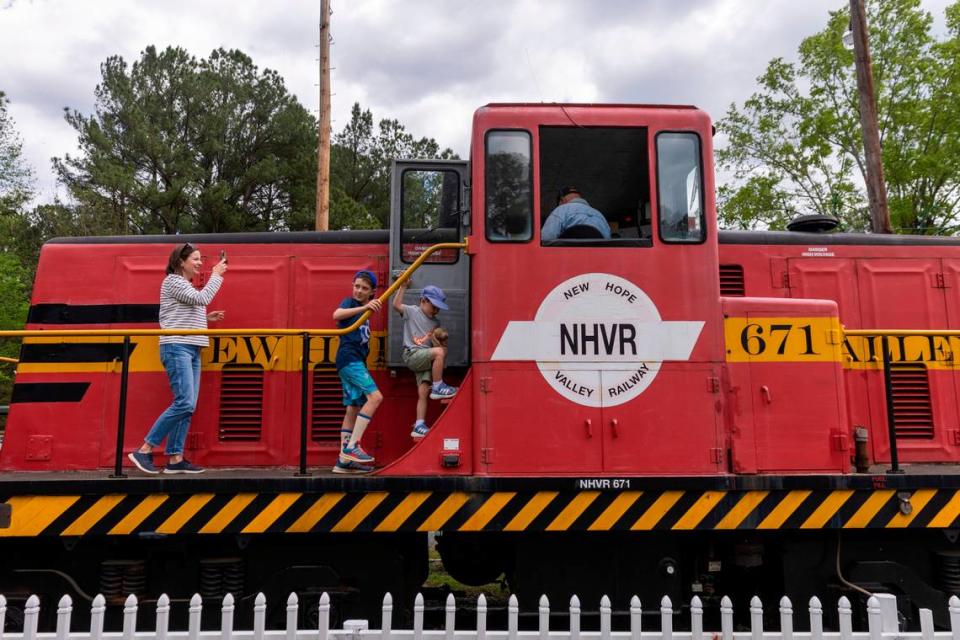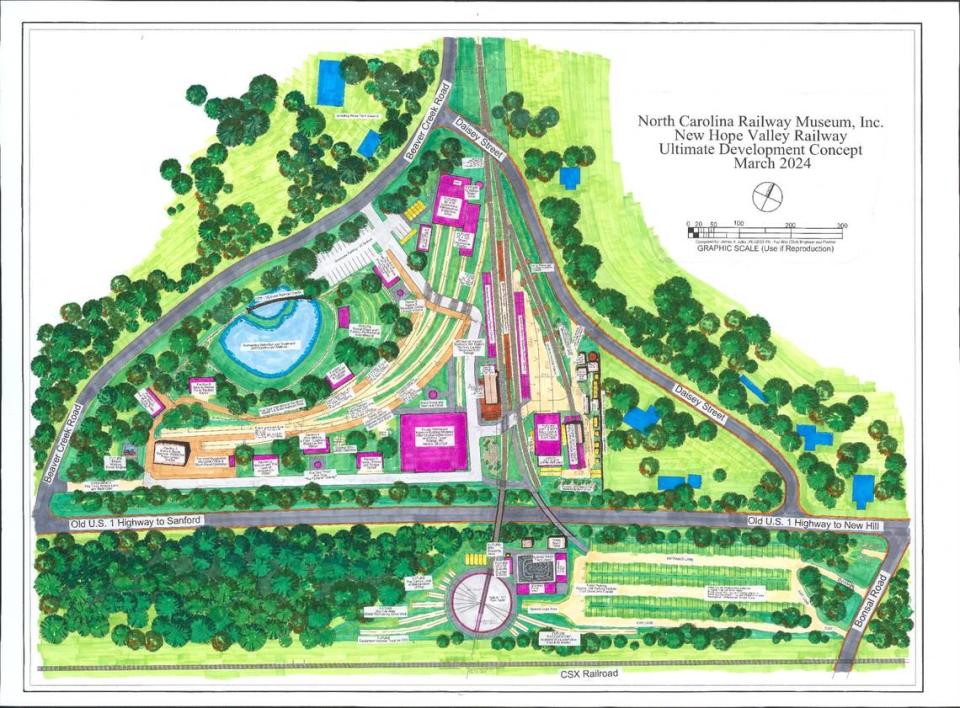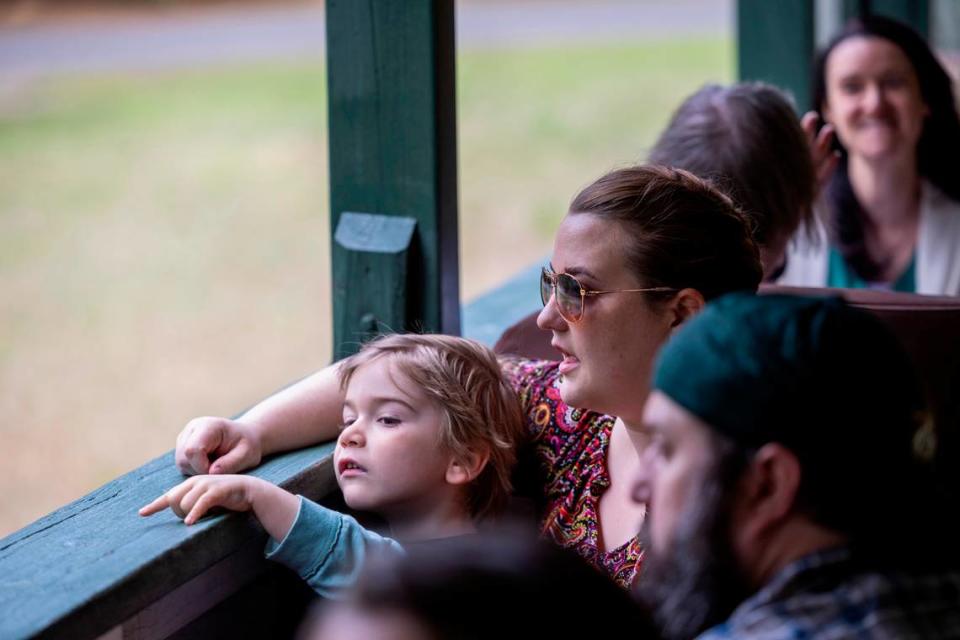‘Something magic.’ New Hope Valley Railway marks 40 years of train rides in Wake County
Long before much of the old Durham & South Carolina Railroad line was turned into the American Tobacco Trail, a group of preservationists bought four miles of the tracks and a small rail yard in southwest Wake County.
They had several old rail cars and two locomotives that they had to move from Farmville. The Southern Railway sold them a piece of its line near New Hill for a bargain price, moved their collection there in August 1982 and then, days later, severed the tracks to Durham, creating a tiny, landlocked railroad in the woods off old U.S. 1.
The preservationists called it the New Hope Valley Railway, the name given to the line by its founder, William Roscoe Bonsal, in 1904. Not only did they have a place to store and work on their old rail cars, but they had enough track to actually operate them, says R. Victor Varney, one of the volunteers who run the railroad and the N.C. Railway Museum that has grown up around it.
“Like any group with some railroad and a few cars that they could get running and a locomotive, they said, ‘You know, we should have people come out and take a train ride,’” Varney said.
That first ride in April 1984 drew 127 people “plus kids,” Varney says. The group put out a can for donations and collected more than $400.

Over the years, the rides became more numerous, and the group’s collection of cabooses, Pullman cars and steam and diesel engines grew. The New Hope Valley Railway now runs two weekend days a month, plus two or three weekdays for school, senior and other groups. There are special Halloween trains and Santa trains at Christmas.
Marco Zarate of Apex brought both his kids here when they were 6 or 7. Now they’re in their 40s, and Zarate recently took a ride with his granddaughter. He struggles to explain it, but something about trains charms and fascinates kids.
“It’s something magic,” said Zarate, a retired environmental engineer who now volunteers with the railway and museum.
It’s not just kids, of course. Simon Varey and Erin Carter of Chatham County came to ride last weekend, with their 9-week-old son Max strapped to his father’s chest. They look forward to riding trains with Max, but for now the enthusiasm is all theirs.
“I’ve always loved trains since I was about his age,” said Varey, who grew up riding trams in Melbourne, Australia.
The couple admired the disassembled pieces of Engine #17, a steam locomotive built in Wilkes-Barre, Pennsylvania, in 1941. The engine pulled trains for the New Hope Valley Railway for 15 years, before being taken out of service in 2017 for repairs and restoration.
“You can really feel the engineering,” Varey said. “It’s more apparent than cars, where it’s all closed in. When they get the steam engine going again it will be even more so. You can see all the parts.”
“Yeah,” Carter added. “The pistons are cool.”
Museum and railway have plans to grow
People who ride the New Hope Valley Railway can also tour the museum’s collection of rail cars, some fully restored, others, like the two steam engines, still needing work.
The organization has created a plan for its 13.5 acres that includes new tracks for displaying equipment, a turntable, a small performing arts space and new buildings for exhibits and education programs. Within a decade, it hopes to break ground on a 29,000-square-foot museum building that would be a replica of the former Union Depot on Nash Square in downtown Raleigh.

The railway also hopes to extend its tracks about 4,400 feet north over an unused portion of the rail line, allowing trains to reach the southern end of the American Tobacco Trail, Varney said.
Ambitious goals for a nonprofit with no paid staff.
“For 40 years of running trains, we’re an all-volunteer operation,” Varney said. “Our job is to basically serve the community and give kids a chance to ride a train.”
The New Hope Valley Railway calls itself the Triangle’s Train (website: triangletrain.com). It’s one of several places in North Carolina where people can ride the rails and travel back in time.
North Carolina Transportation Museum
The state’s transportation museum opened in the early 1980s in Southern Railway’s steam locomotive repair shop in Spencer, near Salisbury. The museum has exhibits on all sorts of conveyances, including cars, trucks, tractors and airplanes. The collection of rail cars, engines and other equipment is the largest in the Carolinas.
Visitors can take a 25-minute ride around the museum property on a train pulled by a vintage diesel engine. The train operates on select days in the spring and Thursday through Sunday from June 1 through Labor Day. For an extra fee, you might be able to ride in the locomotive or the caboose.
For information about times and tickets, go to nctransportationmuseum.org.
The Great Smoky Mountains Railroad
This railroad follows the old Murphy Branch of the Western North Carolina Railroad, offering trips through mountains and along rivers to two destinations from the depot in Bryson City.
One line follows the Tuckasegee River to the town of Dillsboro, where passengers get a layover of an 1 hour and 20 minutes to shop, eat and explore before returning to Bryson City. Along the way, they’ll pass through the Cowee Tunnel and see the bus and locomotive used in the dramatic opening scene of the 1993 film “The Fugitive,” starring Harrison Ford and Tommy Lee Jones, mangled and left along the tracks where the scene was shot..
The other route runs 44 miles across a historic trestle over Fontana Lake into the Nantahala Gorge, with a one-hour layover by the river.
The trains are pulled by either diesel or steam engines, and you’ll want to check the railroad’s schedule if you have a preference. That and ticket information can be found at gsmr.com.
Craggy Mountain Line
Like the N.C. Railway Museum in Bonsal, the Craggy Mountain Line is an all-volunteer organization of rail enthusiasts with a collection of vintage equipment and access to a stretch of track.
In this case, the track leads down to the French Broad River in the town of Woodfin, just north of Asheville. Visitors ride a restored Asheville street car on a seven-mile round trip to Riverside Park and back.
For information, go to craggymountainline.com.
Tweetsie Railroad
This train may be the featured attraction at a western-themed amusement park, but its two narrow-gauge steam engines are the real deal. Both coal-fired engines were built by the Baldwin Locomotive Works in Philadelphia, and both carried passengers and freight on real railroads before coming to the theme park near Boone more than 60 years ago.
Engine No. 12 was built in 1917 and operated on the East Tennessee and Western North Carolina Railroad between Johnson City, Tennessee, and Boone from 1919 to 1940. Engine No. 190, “The Yukon Queen,” was completed in 1943 and ran on Alaska’s White Pass & Yukon Railway between Skagway and Whitehorse, capital of Canada’s Yukon Territory.
The trains make a three-mile loop around the park, which also includes rides, an arcade, a gem mine, a petting zoo and Wild West-themed shows. Open April through October, but days and hours vary. Go to tweetsie.com for more information.

Uniquely NC is a News & Observer subscriber collection of moments, landmarks and personalities that define the uniqueness (and pride) of why we live in the Triangle and North Carolina.


